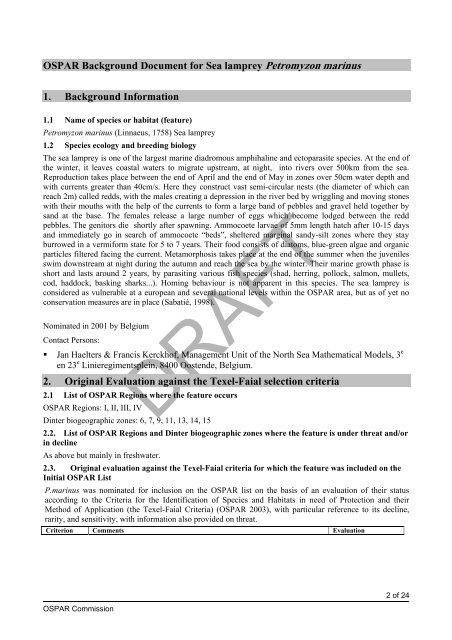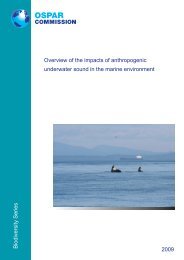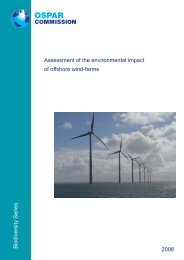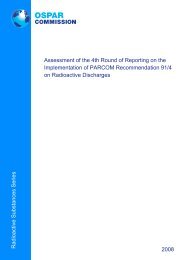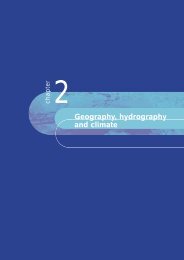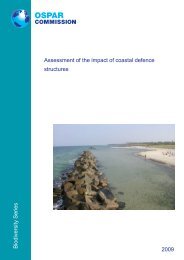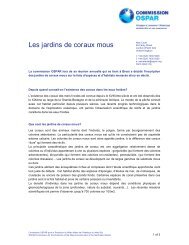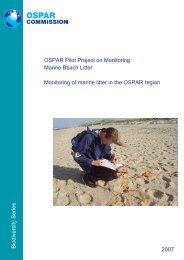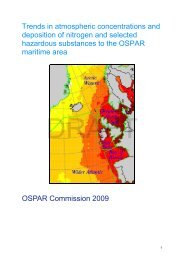OSPAR Background Document for Sea lamprey Petromyzon ...
OSPAR Background Document for Sea lamprey Petromyzon ...
OSPAR Background Document for Sea lamprey Petromyzon ...
Create successful ePaper yourself
Turn your PDF publications into a flip-book with our unique Google optimized e-Paper software.
<strong>OSPAR</strong> <strong>Background</strong> <strong>Document</strong> <strong>for</strong> <strong>Sea</strong> <strong>lamprey</strong> <strong>Petromyzon</strong> marinus<br />
1. <strong>Background</strong> In<strong>for</strong>mation<br />
1.1 Name of species or habitat (feature)<br />
<strong>Petromyzon</strong> marinus (Linnaeus, 1758) <strong>Sea</strong> <strong>lamprey</strong><br />
1.2 Species ecology and breeding biology<br />
The sea <strong>lamprey</strong> is one of the largest marine diadromous amphihaline and ectoparasite species. At the end of<br />
the winter, it leaves coastal waters to migrate upstream, at night, into rivers over 500km from the sea.<br />
Reproduction takes place between the end of April and the end of May in zones over 50cm water depth and<br />
with currents greater than 40cm/s. Here they construct vast semi-circular nests (the diameter of which can<br />
reach 2m) called redds, with the males creating a depression in the river bed by wriggling and moving stones<br />
with their mouths with the help of the currents to <strong>for</strong>m a large band of pebbles and gravel held together by<br />
sand at the base. The females release a large number of eggs which become lodged between the redd<br />
pebbles. The genitors die shortly after spawning. Ammocoete larvae of 5mm length hatch after 10-15 days<br />
and immediately go in search of ammocoete “beds”, sheltered marginal sandy-silt zones where they stay<br />
burrowed in a vermi<strong>for</strong>m state <strong>for</strong> 5 to 7 years. Their food consists of diatoms, blue-green algae and organic<br />
particles filtered facing the current. Metamorphosis takes place at the end of the summer when the juveniles<br />
swim downstream at night during the autumn and reach the sea by the winter. Their marine growth phase is<br />
short and lasts around 2 years, by parasiting various fish species (shad, herring, pollock, salmon, mullets,<br />
cod, haddock, basking sharks...). Homing behaviour is not apparent in this species. The sea <strong>lamprey</strong> is<br />
considered as vulnerable at a european and several national levels within the <strong>OSPAR</strong> area, but as of yet no<br />
conservation measures are in place (Sabatié, 1998).<br />
Nominated in 2001 by Belgium<br />
Contact Persons:<br />
• Jan Haelters & Francis Kerckhof, Management Unit of the North <strong>Sea</strong> Mathematical Models, 3 e<br />
en 23 e Linieregimentsplein, 8400 Oostende, Belgium.<br />
2. Original Evaluation against the Texel-Faial selection criteria<br />
DRAFT<br />
2.1 List of <strong>OSPAR</strong> Regions where the feature occurs<br />
<strong>OSPAR</strong> Regions: I, II, III, IV<br />
Dinter biogeographic zones: 6, 7, 9, 11, 13, 14, 15<br />
2.2. List of <strong>OSPAR</strong> Regions and Dinter biogeographic zones where the feature is under threat and/or<br />
in decline<br />
As above but mainly in freshwater.<br />
2.3. Original evaluation against the Texel-Faial criteria <strong>for</strong> which the feature was included on the<br />
Initial <strong>OSPAR</strong> List<br />
P.marinus was nominated <strong>for</strong> inclusion on the <strong>OSPAR</strong> list on the basis of an evaluation of their status<br />
according to the Criteria <strong>for</strong> the Identification of Species and Habitats in need of Protection and their<br />
Method of Application (the Texel-Faial Criteria) (<strong>OSPAR</strong> 2003), with particular reference to its decline,<br />
rarity, and sensitivity, with in<strong>for</strong>mation also provided on threat.<br />
Criterion Comments Evaluation<br />
<strong>OSPAR</strong> Commission<br />
2 of 24
Global<br />
importance<br />
Regional<br />
importance<br />
Rarity<br />
Sensitivity<br />
Keystone<br />
species<br />
Decline<br />
Both sides of North Atlantic, north to Iceland and along Norwegian coasts to<br />
Barents <strong>Sea</strong> (River Ura, Kola Peninsula). North <strong>Sea</strong>, Baltic and western and central<br />
Mediterranean basins, very rare in Baltic basin, only known to enter Odra, Vistula<br />
(Poland, Germany), Western Dvina (Latvia), Narova and Luga (Russia) drainages.<br />
Several landlocked populations in North America where the construction of the St<br />
Lawrence seaway allowed <strong>lamprey</strong> to enter the great lakes where they have become<br />
a serious pest; none in Europe (Freyhof et al., 2008). Occasional specimens are<br />
taken in midwater in the Atlantic Ocean (Lelek 1973) This does not makes the<br />
<strong>OSPAR</strong> Maritime Area of global importance <strong>for</strong> this species.<br />
<strong>Sea</strong> <strong>lamprey</strong>s are recorded more frequently in estuaries along the Atlantic Arc of the<br />
<strong>OSPAR</strong> Maritme Area; regions III & IV are there<strong>for</strong>e likely to contain a high<br />
proportion of the total sea <strong>lamprey</strong> population within the <strong>OSPAR</strong> area. However,<br />
virtually nothing is known about their distribution during their adult phase at sea.<br />
The sea <strong>lamprey</strong> is much scarcer in western Europe than it was <strong>for</strong>merly, and is rare<br />
in much of its range today (Wheeler 1978).<br />
The sea <strong>lamprey</strong> is probably most sensitive to human activity during its freshwater<br />
stage where poor water quality and degraded spawning habitat can have an impact<br />
on the species. The ammocoete larvae may however be fairly resilient during the<br />
period when they burrow into the silt of rivers and streams, sometimes <strong>for</strong> several<br />
years (<strong>OSPAR</strong> 2006)<br />
Not a species which has a controlling influence on any community within the<br />
<strong>OSPAR</strong> region.<br />
There is no total estimate of the population size of sea <strong>lamprey</strong> in the <strong>OSPAR</strong><br />
Maritime Area but it is known to have declined in many parts of Europe and<br />
particularly so in the last 30 years. It was found in the Scheldt estuary and along the<br />
Belgian coast, <strong>for</strong> example, but is only rarely caught in this area today (Poll, 1945).<br />
It was also present in the Dutch Rhine and Meuse but, because of declines, is now<br />
on the Red Data list of freshwater fishes in the Netherlands as an endangered<br />
species. There are also reports of a decline in Ireland in recent years (Kurz &<br />
Costello, 1999) but no substantive baseline in<strong>for</strong>mation to quantify this (Kelly &<br />
King, 2001).<br />
Table 1: Summary assessment of P.marinus against the Texel-Faial criteria<br />
DRAFT<br />
Does not qualify<br />
Does not qualify<br />
Qualifies<br />
Sensitive<br />
Not applicable<br />
Significant<br />
Threats have not changed since the species was listed, but are further elaborated upon under section 4Error!<br />
Reference source not found., below.<br />
3. Current status of the species or habitat<br />
3.1 Distribution in <strong>OSPAR</strong> maritime area<br />
Figure 1 is a map derived from the GIS data available on EIONET (European Topic Centre on Biological<br />
Diversity) where, in accordance with the provisions of Article 17 of the Habitats Directive, the EU25<br />
Member States reported on the conservation status of all the species and habitats listed in the annexes of the<br />
Directive.With the exception of Germany, no data on this species distribution at sea was made available and<br />
several countries did not submit shapefiles there<strong>for</strong>e the absence/presence depicted is inaccurate. In<strong>for</strong>mation<br />
and distribution maps of this species in Spain, Portugal and Sweden are included in annex 1.<br />
<strong>OSPAR</strong> Commission<br />
3 of 24
DRAFT<br />
Figure 1: Map issued from Member States data submission to EIONET in accordance with article 17 of the EU<br />
Habitats Directive.<br />
The rarity of capture in coastal and estuarine waters suggests that marine <strong>lamprey</strong>s are solitary hunters and<br />
widely dispersed at sea (Henderson 2003). It is quite possible that they often feed in deeper offshore waters<br />
as they have been caught at considerable depths (as deep as 4099 m (Haedrich1977)).<br />
Due to their parasitic adult phase which means their distribution is largely dictated by their host, sea<br />
<strong>lamprey</strong>s do not display any homing (Bergstedt & Seelye, 1995). However they are selective in their choice<br />
of spawning streams and are thought to favour sites where ammocoete larvae are present due to olfactory<br />
cues (Vrieze & Sorensen, 2001). Studies of great lake tributaries in North America showed that it is not<br />
uncommon <strong>for</strong> adult <strong>lamprey</strong> to cease returning to small streams once the larvae have been extirpated<br />
(Torblaa & Westman 1980). There<strong>for</strong>e the higher the concentration of larval pheromones in a stream and the<br />
more likely it is this river will be colonised by genitors: this is noteworthy in terms of stock management and<br />
rein<strong>for</strong>ces the need to restore the marginal sandy-silt zones which are the sea <strong>lamprey</strong>'s larval habitat.<br />
3.2. Population (species) (current/trends/future prospects)<br />
<strong>OSPAR</strong> Commission<br />
4 of 24
Although present levels are still far from historic abundances, certain European rivers (reviewed in<br />
Beaulaton et al., 2008) have shown a recent increase in <strong>lamprey</strong> population size since the 1990's. Future<br />
trends however remain very unclear.<br />
In a study where the observed distribution of P.marinus was related to a set of environmental variables<br />
describing the prevailing climate in the basins, the physical nature of the basins and reflecting historical<br />
events known to have affected freshwater fish (Lassalle et al., 2008) in order to construct predictive models,<br />
projections <strong>for</strong> P. marinus highlighted by the year 2100 a decrease in the presence of this <strong>lamprey</strong> in the<br />
basins bordering the east coast of the Adriatic <strong>Sea</strong>, in most of the Italian basins and in the Iberian Peninsula.<br />
However, conditions remained suitable in the northern part of its present distribution area and the Icelandic<br />
basins became favorable to this species (Fig. 2).<br />
DRAFT<br />
Figure 2 (Lassalle et al., 2008) Potential distribution range of P.marinus under projected climate conditions at the end<br />
of the 21st century. This map is a hypothetic generation of a predictive model.<br />
Few genetic studies have been carried out on the P.marinus but the little that has been done shows that the<br />
sea <strong>lamprey</strong> has a single pan-european population, which implies that it has good genetic resistance. Due to<br />
their lengthy larval life cycle they are subject to typically high interannual population fluctuations be<strong>for</strong>e<br />
returning to the ocean there<strong>for</strong>e certain years a very strong delayed emergence occurs (Lepage, pers.comm).<br />
The impact of human activities has led to a drastic restriction and fragmentation of the distribution area of<br />
sea <strong>lamprey</strong> and has contributed to its placement on the red list of threatened species in Europe (Table 1,<br />
adapted from Beaulaton et al., 2008).<br />
Conservation status Criteria Countries<br />
Extinct<br />
There is no reasonable doubt that the Flanders (Belgium)<br />
last individual has died.<br />
Critically Endangered<br />
Species is facing an extremely high risk<br />
of extinction in the wild in the<br />
immediate future.<br />
United Kingdom, Germany, Spain<br />
(populations from South of Spain)<br />
Endangered<br />
<strong>OSPAR</strong> Commission<br />
Species is not critically endangered but<br />
is facing an extreme risk of extinction<br />
in the near future.<br />
Sweden<br />
5 of 24
Vulnerable<br />
Not evaluated<br />
Data Deficient<br />
Species is not critically endangered or<br />
endangered but is facing a high risk of<br />
extinction in the wild in the mediumterm<br />
future.<br />
Species has not been assessed against<br />
the criteria<br />
Portugal, France, Spain<br />
Table 1.—Conservation status of sea <strong>lamprey</strong> by country in the eastern Atlantic Ocean and western Mediterranean <strong>Sea</strong><br />
according to IUCN (1994) criteria; adapted from Beaulaton et al. (2008).<br />
3.3. Condition (current/trends/future prospects)<br />
No known change since the time it was listed. Future trends are currently very unclear.<br />
Little is known about the natural variability in the population of sea <strong>lamprey</strong> and there<strong>for</strong>e whether the<br />
decline is greater than might be expected through natural change (<strong>OSPAR</strong> 2006). The fact that activities on<br />
river systems are known to have affected the ability of adults to migrate up river does however suggest that<br />
the decline is at least in part due to human activity rather than natural variability.<br />
It is considered that future threats are generally the same as the present pressures, although awareness of<br />
<strong>lamprey</strong> conservation issues is already reducing the impact of river drainage and channel maintenance works<br />
on these species and these activities should be less of a threat in the future. Nonetheless, if sea <strong>lamprey</strong><br />
population levels remain at the apparent present low levels then there is even greater likelihood that some<br />
populations, may fail to achieve favourable conservation status without extensive intervention management<br />
(Igoe et al., 2004).<br />
<strong>Sea</strong> <strong>lamprey</strong> feed on large fish including sharks, adult shad and salmon. It seems likely that the abundance of<br />
sea <strong>lamprey</strong> in <strong>OSPAR</strong> waters may be linked to the abundance of suitable prey in particular shad and<br />
salmon. The reestablishment of large migratory populations of these species in the rivers of a region will<br />
almost certainly aid the re-establishment of large sea <strong>lamprey</strong> populations (Henderson, 2003).<br />
3.4. Limitations in knowledge<br />
DRAFT<br />
No change since the time it was listed.<br />
Only the continental part of their biological cycle is partially known. As is often the case with diadromous<br />
fish species, our present knowledge of the biology and distribution during the marine part of their life cycle<br />
is practically inexistant. The decline in records in its freshwater habitat have provided the data on which this<br />
species has been given international protection throught the EC Habitats and Species Directive and the Bern<br />
Convention (<strong>OSPAR</strong> 2006). It is recommended that a reporting scheme be initiated so that accidental<br />
captures by commercial fishermen and anglers can be recorded. Further research is also needed on the<br />
dispersal during the marine phase in the life cycle, and fidelity to their natal rivers, of sea <strong>lamprey</strong>s,as the<br />
issue of homing has important consequences on the management of European stocks (Beaulaton et al.,<br />
2008).<br />
Due to the absence of bony structures, such as otoliths, scales or spines, investigations on the larval growth<br />
of <strong>lamprey</strong>s have usually relied on the analysis of length-frequency data (Hardisty & Potter, 1971) and<br />
yielded poor results, although recent studies on the use of statolith microchemistry as a technique <strong>for</strong> the<br />
natal origins of sea <strong>lamprey</strong> populations are promising (Hand et al., 2008).<br />
Very little is known about the precise habitats occupied by adult sea <strong>lamprey</strong>s. Although adults are<br />
sometimes caught at sea, the precise conditions in which they occur have not been described, nor is it certain<br />
which fish are the main prey species (Maitland 2003).<br />
<strong>OSPAR</strong> Commission<br />
6 of 24
4. Evaluation of threats and impacts<br />
A summary of the key activities which can cause impacts to P.marinus carried out in inland waters is given<br />
in Table 2.<br />
<strong>Sea</strong> <strong>lamprey</strong>s are vulnerable to habitat modifications and the obstruction by weirs and barrages across their<br />
migratory routes. They are also affected by poor water quality in the larval habitat. Because they are widely<br />
distributed during the marine part of the life cycle there are no specific threats linked to habitat loss or<br />
modification within coastal and estuarine waters (Henderson 2003).<br />
Type of impact Cause of threat Comment<br />
Obstacles<br />
blocking access<br />
to spawning<br />
grounds<br />
Poor water<br />
quality<br />
Loss of substrate<br />
<strong>for</strong> spawning<br />
Overfishing<br />
Habitat<br />
modification<br />
resulting in<br />
uni<strong>for</strong>m channel<br />
structure<br />
Juvenile<br />
mortality<br />
Juvenile<br />
mortality<br />
Eutrophication<br />
Bait digging<br />
Modification of<br />
hydrographic<br />
functioning,<br />
general<br />
Management of<br />
aquatic and bank<br />
vegetation <strong>for</strong><br />
drainage<br />
purposes<br />
Development:<br />
Building of dams and<br />
navigation weirs/lochs<br />
Water pollution:<br />
sewage,<br />
pesticides/herbicides,<br />
heavy metal<br />
contamination<br />
Riverbed sand and<br />
gravel extraction<br />
Removal of sediment<br />
Fishing<br />
Development: land<br />
claim<br />
Uses: shipping<br />
Climate change<br />
Power stations water<br />
intake<br />
Nutrient increase<br />
Fishing<br />
Uses: coastal<br />
<strong>for</strong>estry/farming<br />
Development and<br />
navigational<br />
maintenance<br />
Features such as weirs and dams, may impede migration to spawning grounds. In<br />
comparison to other migratory species, sea <strong>lamprey</strong>s seem to be relatively poor at<br />
ascending obstacles to migration, and are frequently restricted to the lower reaches<br />
of rivers.<br />
Lampreys need well-oxygenated freshwater. As the ammocoetes remain buried in<br />
sandy/silty deposits <strong>for</strong> several years, they are particularly sensitive to the<br />
accumulation of toxins or heavy metals in interstitial water.<br />
Since a large proportion of the life cycle of <strong>lamprey</strong>s is spent in burrows in silt<br />
beds, special attention must be paid to these (not normally considered as important<br />
fish habitat), and to spawning gravels, in considering the impact of a proposed<br />
development on a river.<br />
Probably the most important fishing related mortalities are caused by fish traps in<br />
estuarine waters in localities where <strong>lamprey</strong> concentrate during their upstream<br />
spawning migrations. Although historically the sea <strong>lamprey</strong> has been<br />
commercially fished throughout its European range, nowadays it is much reduced<br />
and limited to fisheries in Spain, Portugal and France. Accidental capture during<br />
trawling in marine waters seems to be rare.<br />
Inappropriate timing of channel maintenance could lead to disruption of redd<br />
structures in gravelled areas with egg washout and dispersal. O’Connor (2004) has<br />
identified arterial drainage as a major factor in altering the hydraulic regime in<br />
impacted channels and, in turn, eliminating juvenile <strong>lamprey</strong> habitat. The<br />
processes of straightening, of removal of bed high points and subsequent <strong>for</strong>mation<br />
of extensive uni<strong>for</strong>m glide areas are considered to have reduced the areas available<br />
<strong>for</strong> natural sediment deposition – the natural homes <strong>for</strong> juvenile <strong>lamprey</strong>.<br />
Water temperature and river discharge, both of which can be altered by climate<br />
change, are the two most important parameters determining marine <strong>lamprey</strong><br />
migratory movement and choice of resting sites.<br />
Long, thin fish are particularly vulnerable to passage through pumps and other<br />
moving machinery. Where cooling water intakes are present, small numbers of<br />
migratory <strong>lamprey</strong> are killed each year. Because of their large size the cooling<br />
water intakes of direct-cooled coastal power stations are almost certainly the most<br />
damaging (Henderson 2003).<br />
Eutrophication acts in a similar way to other <strong>for</strong>ms of pollution. Lush growths of<br />
algae and bacteria associated with increased nutrients smother both the spawning<br />
gravels (preventing spawning or killing eggs) and nursery silts, creating anoxic<br />
conditions there.<br />
There has always been an interest in <strong>lamprey</strong>s (both ammocoetes and adults) from<br />
anglers as bait, and this seems to have increased in recent years and to favour adult<br />
river <strong>lamprey</strong>s in particular. Indiscriminate trapping of adults could damage<br />
populations, and the search <strong>for</strong> larvae (by digging out substrate) not only affects<br />
the population directly but also causes significant damage to their habitat.<br />
In addition to direct impact on ammocoete beds (drying out, modifications in<br />
sediment size) freshwater use <strong>for</strong> agricultural, industrial and domestic purposes is<br />
also responsible <strong>for</strong> a considerable reduction in the river flow. As a consequence,<br />
migratory clues have been eliminated, resulting in a decrease in the number of<br />
adult sea <strong>lamprey</strong>s that enter the rivers to spawn (Almeida et al., 2000).<br />
The diversity of habitats required by <strong>lamprey</strong>s means that any “cleaning” actions<br />
concerning aquatic and bank vegtation need to be carried out with extreme caution.<br />
Unregulated management can lead to monotonous riverine macro-habitats (Sabatié<br />
1998). The presence of lentic waters with silty substrates rich in organic matter are<br />
an essential component of the productivity of the lower trophic levels in a river<br />
DRAFT<br />
<strong>OSPAR</strong> Commission<br />
7 of 24
Type of impact Cause of threat Comment<br />
(organic matter, primary production and invertebrates), the value of which have<br />
been underligned <strong>for</strong> other anadromous species such as sea trout.<br />
Table 2. Summary of key threats and impacts to P.marinus<br />
5. Existing Management measures<br />
The sea <strong>lamprey</strong> is listed on Annexes IIa & Va of the EC Habitats Directive and Annex III of the Bern<br />
Convention. It was classified as Least Concern by IUCN in 2008.<br />
There are no known dedicated monitoring, artificial breeding or re-stocking programmes <strong>for</strong> sea <strong>lamprey</strong>s. A<br />
number of research programmes carrying out migratory fish inventories in river basins are underway in<br />
several contracting countries do record sea <strong>lamprey</strong> presence and biological parameters, but as these research<br />
ef<strong>for</strong>ts are varied, separate and mostly still ongoing results cannot be presented in this assessment.<br />
A considerable amount of research on sea <strong>lamprey</strong> biology has been carried out on in North America where<br />
sea <strong>lamprey</strong> populations invaded the Great Lakes in the 1800's. Since the 1980's a number of costly control<br />
programmes have been developed to prevent the decimation of local landlocked fish populations.<br />
In France where on some river basins the sea <strong>lamprey</strong> supports a thriving fishery (see Annex 1), a minimum<br />
landing size of 40cm is set and the fishing season is limited between the 1 st of December and the 15 th of May.<br />
In Portugal the professional fishing season is set between December and April. No annual quotas per river<br />
basin are currently in place in either France, Portugal or Spain.<br />
6. Conclusion on overall status<br />
There is no known change in the status of this species since it was proposed to be listed by <strong>OSPAR</strong> in 2001.<br />
Future trends are currently very unclear. In Beaulaton et al. (2008), historical data sets <strong>for</strong> four European<br />
rivers (Adour, Garonne, Vilaine and Rhine) show an increase in the number of <strong>lamprey</strong> captured since the<br />
1990's. However, because of the absence of historical or recent data sets <strong>for</strong> comparison over a wider area it<br />
is not possible to make any definitive comment on trends at an <strong>OSPAR</strong> scale, there<strong>for</strong>e even an apparent<br />
positive trend in population should not be interpreted to mean that no further actions are required. Current<br />
management measures concern riverine habitat management and restoration, and while helpful do not appear<br />
to be sufficient to allow <strong>for</strong> the recovery of this species.<br />
Since a large proportion of the life cycle of <strong>lamprey</strong>s is spent in burrows in silt beds, special attention must<br />
be paid to these (not normally considered as important fish habitat), and to spawning gravels, in considering<br />
the impact of a proposed development on a river. Fishery management <strong>for</strong> one group may adversely affect<br />
other wildlife and its habitat. For example, action to improve conditions <strong>for</strong> salmonids (<strong>for</strong> example,<br />
dredging or the provision of fish passes only surmountable by salmonids) may be detrimental to <strong>lamprey</strong><br />
(Maitland, 2003). However, the implementation of Water Framework Directive (WFD) requirements should<br />
lead to improvements in water quality attributes in estuaries and rivers. This may, in turn, facilitate habitat<br />
use by all diadromous species. In addition, physical barriers to upstream migration, may also come under<br />
scrutiny under the WFD, which requires that ‘connectivity’ exist in watercourses. Such geomorphological<br />
connectivity would benefit biological connectivity and would benefit all life history stages of all diadromous<br />
fish species.<br />
DRAFT<br />
Most of the environmental problems affecting sea <strong>lamprey</strong> are in freshwater and estuarine environments, and<br />
there is no evidence that anthropogenic activities in fully marine environments are threatening sea <strong>lamprey</strong><br />
populations. There<strong>for</strong>e, in summary, there seem to be reasonable prospects <strong>for</strong> restoration of the species’<br />
supporting inland habitat. But the extent to which the species’ habitat is restored outwith the designated site<br />
network through the implementation of the Water Framework Directive is unclear at present. Restoring<br />
access <strong>for</strong> the species to areas from which it is excluded by barriers is another potential future restoration<br />
action. Action to restore the morphology of rivers to achieve the objectives of the Water Framework<br />
Directive may help deliver this, but a lack of understanding of the water quantity needs of P.marinus and<br />
some of their exact habitat requirements is a potential hindrance. The difficulty in confidently recording P.<br />
marinus ammocoetes, and hence assessing their population status and range, is a further hindrance. Based on<br />
<strong>OSPAR</strong> Commission<br />
8 of 24
this in<strong>for</strong>mation, it is difficult to confidently justify a judgment on the sea <strong>lamprey</strong>'s overall status (JNCC<br />
2007).<br />
7. Action should be taken at an <strong>OSPAR</strong> level?<br />
.1. Action/measures that <strong>OSPAR</strong> could take, subject to <strong>OSPAR</strong> agreement<br />
7.1.1 <strong>OSPAR</strong> should contact the European Commission and the standing committee of the Bern Convention<br />
to:<br />
a. notify them of the listing under <strong>OSPAR</strong>, threats facing the species, and the willingness of <strong>OSPAR</strong><br />
to co-operate in developing conservation measures;<br />
b. request in<strong>for</strong>mation on the effectiveness of any measures taken <strong>for</strong> the protection of this species;<br />
7.1.2 <strong>OSPAR</strong> should work with relevant Contracting Parties (see Table 3 below) to:<br />
a. raise awareness of status and threats to the species among both management authorities,<br />
fishermen, retailers and the general public.<br />
b. improve comunication and in<strong>for</strong>mation exchanges between P.marinus researchers and authorities<br />
c. improve communication between North American and <strong>OSPAR</strong> region research and management<br />
intiatitives and results<br />
Actions/measures <strong>for</strong> relevant Contracting Parties<br />
7.1.3. <strong>OSPAR</strong> should recommend that relevant Contracting Parties (see Table 3 below):<br />
a. organise a reporting scheme so that the capture of sea <strong>lamprey</strong> by commercial fishermen in<br />
Portugal, Spain & France is recorded and centralised and envisage closing spawning grounds to<br />
fishing from March until May.<br />
DRAFT<br />
b. organise a reporting scheme to gather all abundance data gathering within contracting parties on<br />
ammocoete and/or adults<br />
c. organise a reporting scheme so that the accidental by-catch of sea <strong>lamprey</strong> at sea is logged<br />
systematically in order to further knowledge on the distribution and feeding of sea <strong>lamprey</strong> during<br />
the marine part of their life-cycle.<br />
7.1.4 <strong>OSPAR</strong> should establish a mechanism by which Contracting Parties report back on the implementation<br />
of the above recommendations so that the development of the necessary measures can be evaluated. As a<br />
first step Contracting Parties who have P.marinus present in their coastal waters should make an assessment<br />
of the effectiveness of the regulations they already have in place <strong>for</strong> its protection, consider how those<br />
regulations might be made more effective through improved monitoring, control and surveillance and report<br />
the results to the <strong>OSPAR</strong> Commission.<br />
Suggestions <strong>for</strong> further research<br />
7.1.5. <strong>OSPAR</strong> should emphasise to relevant scientific funding bodies and existing national monitoring<br />
programmes the following research needs with respect to P.marinus:<br />
<strong>OSPAR</strong> Commission<br />
9 of 24
a. further development of decision-support tools such as microsatellite markers and biogeographical<br />
models<br />
b. further international collaboration to investigate the genetic diversity and relationships among the<br />
various populations of sea <strong>lamprey</strong> in Europe.<br />
c. further data collection, harmonisation and collation to increase the baseline data collection where<br />
resources allow.<br />
d. research relevant to the reintroduction of the sea <strong>lamprey</strong> to sites from which it has been excluded<br />
by pollution, dams and weirs<br />
e. further studies regarding the sea <strong>lamprey</strong>’s preferential resting sites and migratory movement<br />
Table 3: Summary of key threats and existing protection <strong>for</strong> <strong>Petromyzon</strong> marinus<br />
Key threats<br />
Relevant Contracting Parties<br />
Other responsible authorities<br />
Already protected?<br />
Measures adequate?<br />
Encountered in inland waters; habitat alteration, pollution,<br />
activities that result in altered river flow rate.<br />
Iceland, UK, Ireland, Belgium,the Netherlands, Germany,<br />
Denmark, Norway, Sweden, France, Spain, Portugal<br />
EC, FAO, RFMOs<br />
Habitat & Species Directive One of the first steps contracting<br />
Annex IIa and Va<br />
countries are recommended to take<br />
(excepting the Swedish is an assessment of the<br />
populations)<br />
effecttiveness of the regulations<br />
Bern Convention Annex III they already have in situ, and how<br />
Barcelona Convention those regulations might be made<br />
Annex III<br />
more effective through improved<br />
IUCN Red List LC (Least monitoring, control and<br />
Concern)<br />
surveillance.<br />
7.2 Brief Summary of monitoring system to be implemented (c.f annex 2)<br />
DRAFT<br />
As <strong>for</strong> the allis shad, a set protocol <strong>for</strong> monitoring the river, brook and sea <strong>lamprey</strong> (Lampetra fluviatilis,<br />
Lampetra planieri and <strong>Petromyzon</strong> marinus) has been produced in the UK as part of Life in UK Rivers<br />
(Harvey & Cowx, 2003) – a project to develop methods <strong>for</strong> conserving the wildlife and habitats of rivers<br />
within the Natura 2000 network of protected European sites.<br />
<strong>Sea</strong> <strong>lamprey</strong>s are caught so infrequently at sea and so little is known about their maritime distribution that a<br />
targeted marine monitoring system is not feasible.<br />
Annex.1 Overview of data and in<strong>for</strong>mation provided by Contracting Parties<br />
Contracting<br />
Party<br />
Feature<br />
occurs in<br />
CP’s<br />
Maritime<br />
Area<br />
Belgium Y Y<br />
Denmark Y Y<br />
European<br />
Contribution made to<br />
the assessment<br />
(e.g. data/in<strong>for</strong>mation<br />
provided)<br />
National reports<br />
References or weblinks<br />
<strong>OSPAR</strong> Commission<br />
10 of 24
Commission<br />
France Y Y Beaulaton L., Taverny C. and Castelnaud G., 2008.<br />
Fishing, abundance and life history traits of the<br />
anadromous sea <strong>lamprey</strong> (<strong>Petromyzon</strong> marinus) in<br />
Europe. Fisheries Research 92: 90-101.<br />
Girardin M., Castelnaud G., Beaulaton L., 2006.<br />
Surveillance halieutique de l'estuaire de la Gironde<br />
– Suivi des captures 2004 – Etude de la faune<br />
circulante 2005. Rapport pour EDF CNPE du<br />
Blayais/ Etude Cemagref, groupement de<br />
Bordeaux, Cestas. N°105, 211p.<br />
Keith P. and Allardi J.(coord), 2001. Atlas des<br />
poissons d'eau douce de France. Patrimoines<br />
Naturels 47: 387p.<br />
Germany Y Y Fricke R. 1987. Deutsche Meeresfische.<br />
Bestimmungsbuch. Hamburg (DJN), 219 pp.<br />
Meyer, Lutz (2009): On the situation of sea<br />
<strong>lamprey</strong> stocks in the catchments of the Rivers<br />
Elbe, Weser and Ems (Lower Saxony). – Lower<br />
Saxony Federal State Office <strong>for</strong> Consumer<br />
Protection and Food Safety, Department <strong>for</strong> Inland<br />
Fisheries; written communication from<br />
29.01.2009.<br />
Spratte, S (2009): Short overview on the situation<br />
of the sea <strong>lamprey</strong> stocks in the catchments of the<br />
Rivers Elbe and Eider (Schleswig-Holstein). –<br />
Landesamt für Landwirtschaft, Umwelt und<br />
ländliche Räume des Landes Schleswig-Holstein<br />
(LLUR), Außenstelle Kiel (Fischerei), Abt. 3<br />
Fischerei, Dezernat Binnenfischerei und<br />
Aquakultur; personal communication from<br />
29.01.2009.<br />
Iceland Y Y<br />
DRAFT<br />
Ireland Y Y http://www.npws.ie/en/PublicationsLiterature/Hab<br />
itatsDirectivereport07/Species/<br />
Igoe F., Quigley D.T.G., Marnell F., Meskell E.,<br />
O’Connor W. & Byrne C., 2004. The sea <strong>lamprey</strong><br />
<strong>Petromyzon</strong> marinus (L.), river <strong>lamprey</strong> Lampetra<br />
fluviatilis (L.) and brook <strong>lamprey</strong> Lampetra<br />
planeri (Bloch) in Ireland: general biology,<br />
ecology, distribution and status with<br />
recommendations <strong>for</strong> conservation. Biology and<br />
Environment: Proceedings of the Royal Irish<br />
Academy 104B: 43–56.<br />
Kurz, I. and Costello, M. J. 1999 An outline of the<br />
biology, distribution and<br />
conservation of <strong>lamprey</strong>s in Ireland. Irish Wildlife<br />
Manuals No. 5. Dublin, Duchas –<br />
the Heritage Service.<br />
Netherlands Y Y http://library.wur.nl/way/bestanden/clc/1883069.p<br />
<strong>OSPAR</strong> Commission<br />
11 of 24
df (Dutch report with distribution maps)<br />
Norway Y Y<br />
Portugal Y Y http://www-heb.pac.dfompo.gc.ca/congress/2002/Lamprey/Almeida.pdf<br />
Spain Y Y<br />
Alfonso A.& Vaz-Pires, P. (1992): A pesca da<br />
lampreia (<strong>Petromyzon</strong> marinus) no estuario<br />
do rio Lima. Instituto Nacional de<br />
Investigaçao das Pescas Publicaçoes<br />
Avulsas, 17: 179-197.<br />
Americo Sousa, J. (1992): Fase larvar e<br />
metamorfose da populaçao de lampreia<br />
(<strong>Petromyzon</strong> marinus) no estuario do rio<br />
Lima. Instituto Nacional de Investigaçao<br />
das Pescas Publicaçoes Avulsas, 17: 199-<br />
227.<br />
Beamish, F.W.H., Potter, I.C.& Thomas, E.<br />
(1979): Proximate composition of the<br />
anadromous sea <strong>lamprey</strong>, <strong>Petromyzon</strong><br />
marinus. Environmental Biology of Fishes<br />
4 (1): 1-9.<br />
Doadrio, I. (Ed) (2001): Atlas y Libro Rojo de los<br />
Peces Continentales de España. 2ª Edición.<br />
CSIC/MIMAM: 374 pp.<br />
Granado, C. (2001): Lamprea marina, p.15, in:<br />
Libro Rojo de los Vertebrados Amenazados<br />
de Andalucía. Consejería de Medio<br />
Ambiente. Junta de Andalucía. 336 pp.<br />
Sweden Y Y -Ljunggren, N. & M. Söderman 2008. Inventering<br />
av havs- och flodnejonöga i Halland 2008.<br />
Länsstyrelsen Halland, Enheten för naturvård och<br />
miljöövervakning. Meddelande 2008:XX<br />
(unpublished)<br />
-Nathanson, J.E. & T. Soler 2009: Åtgärdsprogram<br />
för bevarande av Havsnejonöga. Fiskeriverket och<br />
Naturvårdsverket.(unpublished)<br />
-Nathanson, J.-E. & T. Soler 2007. Havsnejonöga,<br />
<strong>Petromyzon</strong> marinus. s. 31-33. Ur: Tjernberg, M.<br />
& M. Svensson (red.) Artfakta. Rödlistade<br />
ryggradsdjur i Sverige. ArtDatabanken, SLU,<br />
Uppsala.<br />
UK Y Y<br />
http://www.jncc.gov.uk/pdf/Article<br />
17/FCS2007-S1095-audit-<br />
Final.pdf<br />
DRAFT<br />
http://www.englishnature.org.uk/LIFEinUKRivers/publications/lampr<br />
ey.pdf<br />
http://www.jncc.gov.uk/ProtectedSites/SACselecti<br />
on/species.asp?FeatureIntCode=S1095<br />
<strong>OSPAR</strong> Commission<br />
12 of 24
Barnes, M.K.S., 2008. <strong>Petromyzon</strong> marinus. <strong>Sea</strong><br />
<strong>lamprey</strong>. Marine Life In<strong>for</strong>mation Network:<br />
Biology and Sensitivity Key In<strong>for</strong>mation Subprogramme<br />
[on-line]. Plymouth: Marine<br />
Biological Association of the United Kingdom.<br />
[cited 21/11/2008]. Available from:<br />
<br />
Davies CE, Shelley J, Harding PT, Mclean, IFG,<br />
Gardiner R and Peirson, G (eds.). 2004.<br />
Freshwater fishes in Britain. The species and their<br />
distribution. Harley Books, Colchester.<br />
Summaries of country-specific in<strong>for</strong>mation provided<br />
Britain<br />
<strong>Petromyzon</strong> marinus is reasonably widespread in UK<br />
rivers. Records are concentrated in East Anglia, the<br />
South-West and south and east Scotland. The rivers<br />
Wye and Severn are particular strongholds, together<br />
with several rivers in Wales (Davies et al., 2004). There<br />
are no records from the Northern Isles and the inner<br />
Hebrides, and it appears to be absent from much of<br />
North-West England and the Midlands, with only sparse<br />
records from the southern counties of England (Davies<br />
et al., 2004).<br />
Figure 3 Distribution map of P.marinus in the UK and<br />
Ireland- courtesy of MarLIN<br />
DRAFT<br />
Ireland<br />
Kurz and Costello (1999) compiled the first review of available in<strong>for</strong>mation on records of all three taxa in<br />
Ireland. Between this baseline and subsequent survey work, considerable awareness has been created and<br />
many additional records added. Spawning has been observed in the R. Moy in Ballina, the R. Corrib in<br />
Galway city, the Fergus in Ennis, the Shannon at Castleconnell and Plassey, the neighbouring R. Mulkear at<br />
Annacotty, at the Cork Waterworks on the R. Lee, the Munster Blackwater in Fermoy and in the R. Suir at<br />
Clonmel. Redd count surveys have been undertaken by Central Fisheries Board on the Munster Blackwater<br />
and Slaney (King & Linnane 2004) and on the Suir and Nore (CFB unpublished data). These have permitted<br />
an appraisal of location and extent of spawning ef<strong>for</strong>t. Staff of Eastern Regional Fisheries Board recorded a<br />
sea <strong>lamprey</strong> on the R. Glyde in May 2007 and on the R. Vartry in June 2007, in what may be the first records<br />
<strong>for</strong> these systems. Evidence of redd construction, but without sightings of adult fish, have come from ERFB<br />
staff on the Boyne and Liffey. When an ERFB record from the Avoca catchment is added, this points to a<br />
penetration of all the major east-coast catchments by <strong>Petromyzon</strong> marinus.<br />
<strong>OSPAR</strong> Commission<br />
13 of 24
There is no recorded coverage <strong>for</strong> sea <strong>lamprey</strong> from the R. Lee around the west Cork and Kerry coasts to<br />
Castlemaine. This may be largely a consequence of their not being observed in many of these remote and<br />
thinly-populated areas. <strong>Sea</strong> <strong>lamprey</strong> adults are reported from the Killarney National Park (Kurz & Costello<br />
1999) and from the R. Feale (O’Connor 2006 (a); P. Halpin, ShRFB pers. comm.). The species is widely<br />
recorded in waters of the Shannon estuary and major tributaries – in the Deel (P. Halpin, ShRFB pers<br />
comm.), Fergus, Shannon and Mulkear. There are also some records pointing to the presence of a landlocked<br />
population of sea <strong>lamprey</strong> in L. Derg (O’ Connor pers comm.; ESB 1998; responses to CFB website).<br />
Apart from records in Galway city and occasional records from Oughterard, there are no reports on the<br />
Galway and west Mayo coastline or influent channels. <strong>Sea</strong> <strong>lamprey</strong> are commonly reported on the Moy and<br />
from the Deel, a tributary catchment of L. Conn. In 2007, adult fish were also reported well up the catchment<br />
in the Castlebar River and in the R. Eignagh by Fisheries Board staff (P. Traynor, NWRFB pers. comm.; G.<br />
Wightman CFB). There are records of sea <strong>lamprey</strong> from the Garavogue system, with one email report of a<br />
sea <strong>lamprey</strong> in Sligo as early as January (Diarmuid Neilan, pers. comm.).<br />
France<br />
<strong>Sea</strong> <strong>lamprey</strong>s are present in a number of small rivers in Brittany, in the Loire, the Gironde estuary, the<br />
Adour, and in the Rhône and a few other mediterranean streams (Fig. 4). The Loire, Gironde-Garonne-<br />
Dordogne river system and the Adour support a professional and non-professional sea <strong>lamprey</strong> fishery which<br />
targets adult individuals on their upstream migration, and takes place between the 1 st of December and the<br />
15 th of May. In 2003 total <strong>lamprey</strong> production was estimated as being 150.5 tonnes, with an average price of<br />
12 euros per kilo (Girardin et al., 2006). Although no quota is set, the minimum landing size <strong>for</strong> <strong>lamprey</strong> is<br />
40cm. The mean catch of the Garonne basin, over the period 1985–2003, was 72 t, confirming the top rank<br />
of the Garonne Basin sea <strong>lamprey</strong> population and of its fisheries. <strong>Sea</strong> <strong>lamprey</strong> abundance appears to have<br />
peaked strongly between 1952 and 1970. From 1973 onwards, the trend is stable and abundance was only<br />
35–40% of the maximum level. Since the end of the 1990s, the CPUE has shown a strong increase—a sign<br />
of an upward trend in <strong>lamprey</strong> abundance (Beaulaton et al., 2008).<br />
DRAFT<br />
<strong>OSPAR</strong> Commission<br />
14 of 24
Figure 4 Distribution of P.marinus spawning sites in French river systems (Keith & Allardi 2001).<br />
Migratory Fish Management Committees (COGEPOMI – Comités de Gestion des Poisson Migrateurs) have<br />
been set up <strong>for</strong> 8 major river basins in France established under the 1984 Fisheries Act and Decree No. 94-<br />
157 of 16 February 1994. They draw up 5-year management plans <strong>for</strong> individual river-basins, watercourses<br />
or groups of watercourses, setting out fishery management regulations tailored to the type of commercial or<br />
recreational fishing practised there, as well as conservation measures where necessary. These Management<br />
Committees represent the authorities and the industry. In addition to the sea <strong>lamprey</strong>, 6 other species are<br />
managed by these committees: the river <strong>lamprey</strong> (Lampetra fluviatilis), the Atlantic salmon (Salmo salar),<br />
the allis shad (Alosa alosa), the twaite shad (Alosa fallax), the european eel (Anguilla anguilla) and the<br />
brown trout (Salmo trutta).<br />
Germany<br />
DRAFT<br />
There are only sparse data on the distribution (spatial, seasonal) of sea <strong>lamprey</strong> in the German part of the<br />
North <strong>Sea</strong>, because this species is caught only accidentally by commercial fisheries or scientific fishing<br />
surveys.<br />
In the following, in<strong>for</strong>mation is provided on distribution and abundance of the sea <strong>lamprey</strong> in the German<br />
Federal State of Lower-Saxony hosting the main tributaries to the German North <strong>Sea</strong> area.<br />
According to historical references from around 1900, sea <strong>lamprey</strong> seemed to be not abundant in the<br />
catchments of the Rivers Ems, Weser, Elbe and Eider and was concordantly characterized as “rare”.<br />
There<strong>for</strong>e, sea <strong>lamprey</strong>s have never been an object of commercial fishery, in contrast to the anadromous<br />
river <strong>lamprey</strong> (Lampetra fluviatilis). The occurrence (or spawning) of this species was also documented <strong>for</strong><br />
several major tributaries in the tidal reaches of the above-mentioned Rivers.<br />
Meanwhile until the 1980s the sea <strong>lamprey</strong> became almost extinct in the Northern German tributaries to the<br />
North <strong>Sea</strong>, due to heavy water pollution (especially in the estuaries), the building of migration barriers and<br />
<strong>OSPAR</strong> Commission<br />
15 of 24
the alteration of water courses in the adjacent river systems. However, since 1995 the stocks of sea <strong>lamprey</strong>s<br />
are remarkably increasing again (especially in the catchment of the tidal River Elbe), probably due to the<br />
improved water quality following the political changes in Central Europe since 1990 (Rivers Elbe and<br />
Weser) and the restoration of water courses (e. g. the improvement of fish passage facilities) since the<br />
program <strong>for</strong> management of water courses of Lower Saxony started in 1992.<br />
Although annual spawning migrations of sea <strong>lamprey</strong> are documented in all the estuaries, the current<br />
situation of sea <strong>lamprey</strong> stocks in the catchments of the Rivers Elbe, Weser and Ems differ remarkably.<br />
River Elbe: The estimated by-catch of sea <strong>lamprey</strong>s by commercial fyke netting on eel in the tidal reach<br />
upstream Hamburg amounts to approximately 500/a on average (<strong>lamprey</strong>s are generally released). Spawning<br />
ascent and/or spawning is regularly documented in all major tributaries of the tidal Elbe in the federal states<br />
Lower Saxony (Oste, Schwinge, Aue-Lühe, Este, Seeve, Luhe, Ilmenau) and Schleswig-Holstein (Stör,<br />
Pinnau, Krückau and some smaller tributaries of the Nord-Ostsee-Kanal, S. Spratte, personal<br />
communication, 29.01.2009), sometimes on artificial riffle structures (e. g. in the tailrace of hydroelectric<br />
power stations s of or under road bridges). Altogether, the estimated number of sea <strong>lamprey</strong>s ascending into<br />
the Lower Saxonian tributaries also amounted to approximately 500/a on average, based on systematic<br />
surveys on spawning sites in 2001-2003 (with a considerable number of unreported cases). <strong>Sea</strong> <strong>lamprey</strong>s are<br />
also annually documented in the Middle Elbe by stow netting about 100 or 200 km respectively upstream the<br />
tidal weir at Geesthacht. Due to the fact, that most of them obviously are spent <strong>lamprey</strong>s, spawning on large<br />
gravel banks in the Middle Elbe (Saxony-Anhalt) seems to be likely.<br />
In Schleswig-Holstein a spawning ascent is also observed in the River Treene (River Eider catchment), (S.<br />
Spratte, personal communication, 29.01.2009).<br />
River Weser: Based on the number of sea <strong>lamprey</strong>s documented by non commercial fyke netting in the<br />
tailwater of the weir at Bremen-Hemelingen the annual spawning run in the tidal River Weser amounts to an<br />
estimated number of several hundred <strong>lamprey</strong>s at least. Additionally, a number of approximately < 100 sea<br />
<strong>lamprey</strong>s are annually documented from detected spawning sites in the tributaries of the tidal river Weser<br />
(Hunte, Wümme, Ochtum, Delme). In contrast, the situation of the sea <strong>lamprey</strong> stock in the catchment of the<br />
Middle Weser is unknown up to now (only one proof of a male sea <strong>lamprey</strong> in the River Leine after a flood<br />
period in spring 2002).<br />
River Ems: The estimated number of sea <strong>lamprey</strong>s annually ascending through the River Ems estuary<br />
documented by stow net fishery is small (< 100 on average) compared to the estuaries of River Elbe and<br />
Weser, due to problems connected with temporary deficits in oxygen saturation and extreme high turbidity.<br />
In the past spawning migration in the Middle Ems was obstructed by the almost impassable weir at<br />
Bollingerfähr (upstream the tidal weir at Herbrum). Spawning in the River Ems or the tributaries (catchment<br />
of Leda-Jümme) was not detected up to now, particularly suitable spawning sites are lacking.<br />
DRAFT<br />
In the updated Red List of Freshwater Fishes of Lower Saxony the sea <strong>lamprey</strong> has been downgraded from<br />
“near to extinction” to “seriously endangered”.<br />
Furthermore, the sea <strong>lamprey</strong> in Lower Saxony will also profit by the continued implementation of the<br />
“Council Directive 92/43/EEC of 21 May 1992 on the conservation of natural habitats and of wild fauna and<br />
flora” and the “Directive 2000/60/EC of the European Parliament and of the Council of 23 October 2000<br />
establishing a framework <strong>for</strong> Community action in the field of water policy”.<br />
Portugal<br />
The sea <strong>lamprey</strong> (<strong>Petromyzon</strong> marinus L.) supports commercial fisheries in most of the major Portuguese<br />
river systems (Fig. 5), particularly in the central and northern regions of the country.<br />
<strong>OSPAR</strong> Commission<br />
16 of 24
Figure 5: Habitat available to sea <strong>lamprey</strong> populations in Portuguese river basins where the species is known to occur.<br />
<strong>Sea</strong> <strong>lamprey</strong>s are considered a delicacy in Portugal and, due to the high economic value of this fishery (one<br />
animal can cost as much as € 45), the main Portuguese estuaries and rivers are crowded with fishermen and<br />
poachers during the annual sea <strong>lamprey</strong> spawning migration. These intense fisheries along with the reduction<br />
of suitable habitat, due to the construction of impassable dams, are the major threats to the survival of this<br />
species in Portuguese river basins.<br />
DRAFT<br />
There are intense sea <strong>lamprey</strong> fisheries: the exploitation in the Minho and Tagus river are assessed to<br />
40,000–60,000 and 2500–5000 <strong>lamprey</strong>s respectively (Almeida, P.R., personal communication).<br />
The Netherlands<br />
The <strong>Sea</strong> <strong>lamprey</strong> used to migrate from the North <strong>Sea</strong> upstream in the river Rhine up to Basel and in the<br />
Meuse up to deep in Belgium. Also in the Scheldt and the Ems the sea <strong>lamprey</strong> was common.<br />
Since 1960 numbers have declined steeply with minimum numbers reached in the ‘70s and ‘80s.<br />
However, <strong>Sea</strong> <strong>lamprey</strong> never completely disappeared from the Meuse and the Rhine. Since 1990 there is a<br />
slight, but continuous, increase in numbers in the rivers and the IJsselmeer.<br />
The larvae of the <strong>Sea</strong> Lamprey grow up in the Netherlands, but adult individuals also pass through the<br />
Netherlands when migrating to spawning areas in Germany and Belgium. It is possible that there are even<br />
spawning sites in the Nederlands.<br />
Probable cause <strong>for</strong> the decline in numbers were the water quality and the blockage of passages through<br />
dams and sluices.<br />
17 of 24<br />
<strong>OSPAR</strong> Commission
Spain<br />
In the Spanish <strong>OSPAR</strong> Area, <strong>Petromyzon</strong> marinus, is present on the Cantabrian and Galician coasts, and in<br />
the Guadalquivir and Guadiaro estuaries, Guadalete river, Barbate river and Guadiana River (fig.6). Its<br />
present distribution extension covers less than 2000 km2. (2007 data) ; southern populations are critically<br />
endangered while the northern populations are suffering a strong decline (with the exception of Galician<br />
Atlantic river populations).<br />
Evaluation of threats and impacts<br />
The decline in the Spanish populations is mainly based on deteriorating living conditions in watercourse<br />
habitats, such as pollution, reclamation projects, dredging projects, migration obstacles etc. Also, the<br />
overfishing activities are a threat <strong>for</strong> the species.<br />
The following conservation measures are proposed:<br />
Fishing regulations <strong>for</strong> all the populations.<br />
Establishment of fish passes.<br />
Control of dredging materials<br />
Control of river pollution.<br />
Figure 6: Habitat available to sea <strong>lamprey</strong> populations in Spanish river basins where the species is known to occur.<br />
Sweden<br />
<strong>Sea</strong> <strong>lamprey</strong> in Sweden comprises only a small part of the world population. From the 19th century and<br />
onwards, it is described as being of infrequent or rare occurrence. It is primarily found in watercourses<br />
debouching to the Kattegat or Öresund. Occurrence in watercourses debouching to the Skagerrak or the<br />
Baltic <strong>Sea</strong> is rarer. From the province of Blekinge and northward, reports of occurrence are few. The<br />
northernmost catch was made 1965 in the Rickle stream (the province of Västerbotten).<br />
DRAFT<br />
The watercourse where most reproductive individuals go up to spawn is likely the river Ätran in the province<br />
of Halland. Attached is a figure of the distribution in the main watershed areas in Sweden.<br />
<strong>OSPAR</strong> Commission<br />
18 of 24
DRAFT<br />
Figure 7. Distribution of the sea <strong>lamprey</strong> (<strong>Petromyzon</strong> marinus) in Swedish main drainage areas be<strong>for</strong>e and after 1980,<br />
and spawning observation after 2005.<br />
Population (current/trends/future prospects)<br />
On the Swedish Red List <strong>for</strong> the year 2005, sea <strong>lamprey</strong> is listed as ”Endangered” (EN).<br />
The listing is due to the fact that the population is estimated to comprise fewer than 2500 mature<br />
individuals, and that the stock has declined by at least 10% over the last 24-30 years (three<br />
generations). No subpopulation (watercourse) has more than 250 reproductive individuals. In the<br />
past two generations, the decline has been 20%.<br />
It is difficult to estimate the population trend <strong>for</strong> the next ten years. Improvement in watercourse<br />
biotopes such as fish passes, clearing of migration obstacles, etc., may in time favour the species.<br />
Possibly the most current threat to the species is the deteriorating living conditions in the marine and<br />
coastal areas, as well as an increasingly limited access to food.<br />
<strong>OSPAR</strong> Commission<br />
19 of 24
The distribution and population status of sea <strong>lamprey</strong> should be favoured by a warmer climate in the<br />
Northern hemisphere.<br />
Condition (current/trends/future prospects)<br />
Detailed knowledge of population growth and yield is lacking in this country.<br />
Limitations of knowledge<br />
In the summer of 2008, the first directed inventory of the species was conducted. All watercourses<br />
containing sea <strong>lamprey</strong> in Halland were surveyed. In nine rivers, spawning was observed.<br />
Reproductional sucess in earlier years was inventoried using electric fishing of larvae. In two<br />
watercourses, the spawning fish were counted.<br />
Similar studies to those made in Halland should be conducted in other parts of the area of<br />
distribution, in all events in those watercourses that debouch to the Skagerrak, Öresund and the<br />
southern Baltic <strong>Sea</strong>. When the occurrence has been mapped, a (standardized) methodology <strong>for</strong><br />
monitoring should be established in order to facilitate comparisons with other populations occurring<br />
in Europe.<br />
In order to optimize directed measures, those activities detrimental to the species in those water<br />
systems where spawning and larva growth are taking place should be identified.<br />
The greatest knowledge gap is with regard to the marine environment, such as choice of food, the<br />
condition of prey at the moment of attack, and the growth environments in use in the marine and<br />
coastal areas.<br />
In addition, knowledge of the genetic exchange between the Swedish population(s) and those at<br />
more southern latitudes would be of value.<br />
Evaluation of threats and impacts<br />
The decline in the population specified in the Swedish Red List is based on deteriorating living<br />
conditions in watercourses, such as pollution, reclamation projects, migration obstacles etc. Also, the<br />
increasingly lower occurrence of cod species along the Swedish coast is an worrying factor.<br />
DRAFT<br />
What might favour the species in time is the improving water quality in Swedish watercourses, and<br />
that fish management of salmon species may also favour other species such as sea <strong>lamprey</strong>.<br />
Existing Management measures<br />
In Sweden, the catching of sea <strong>lamprey</strong> is prohibited (FIFS 2004:36 concerning fishing in the<br />
Skagerrak, the Kattegat and the Baltic <strong>Sea</strong>, and FIFS 2004:37 concerning freshwater fish). The<br />
prohibition is with regard to the intentional catching and killing of sea <strong>lamprey</strong>.<br />
In order to improve the situation, a national action plan <strong>for</strong> sea <strong>lamprey</strong> is to be instituted. Prioritized<br />
measures will be biotope improvement (fish passes and restoration of important environments), reintroduction<br />
and area protection. The inventories made are to be the basis of population surveillance.<br />
To increase knowledge concerning the species, a certain amount of in<strong>for</strong>mational material will be<br />
assembled. In general, it is of importance that the protection and consolidation of the species will be<br />
addressed and highlighted when reviewing current court judgements and regulations. <strong>Sea</strong> <strong>lamprey</strong><br />
should also be taken into consideration in court trials of water activities which may have<br />
consequences <strong>for</strong> the long-term survival of the species.<br />
<strong>OSPAR</strong> Commission<br />
20 of 24
Annex 2. Description of the recommended monitoring and assessment strategy<br />
A protocol <strong>for</strong> monitoring the river, brook and sea <strong>lamprey</strong> (Lampetra fluviatilis, Lampetra planieri and<br />
<strong>Petromyzon</strong> marinus) has been produced as part of Life in UK Rivers (Harvey & Cowx, 2003) – a project to<br />
develop methods <strong>for</strong> conserving the wildlife and habitats of rivers within the Natura 2000 network of<br />
protected European sites. The project’s focus has been the conservation of rivers identified as Special Areas<br />
of Conservation (SACs) and of relevant habitats and species listed in annexes I and II of the European Union<br />
Directive on the Conservation of Natural Habitats and of Wild Fauna and Flora (92/43/EEC) (the Habitats<br />
Directive). Given resource constraints, this protocol seeks to develop a programme that can monitor<br />
compliance with conservation objectives in a realistic and cost-effective way.<br />
For a more detailed protocol on the monitoring of river, brook and sea <strong>lamprey</strong> please see<br />
http://www.english-nature.org.uk/lifeinukrivers/species/<strong>lamprey</strong>_monitoring.pdf<br />
1. Rationale <strong>for</strong> the proposed monitoring<br />
Regular monitoring of the migrating sea <strong>lamprey</strong> population will be necessary to guarantee the effectiveness<br />
of measures taken to restore the species to a favourable conservation status in the <strong>OSPAR</strong> Maritime Area.<br />
n/a<br />
2. Use of existing monitoring programmes<br />
3. Synergies with monitoring of other species or habitats.<br />
Attempts should be made to combine monitoring of <strong>lamprey</strong> ammocoetes with routine juvenile salmonid<br />
monitoring. The use of existing salmonid monitoring sites has a number of advantages (Harvey & Cowx<br />
2003):<br />
• Existing sites are generally situated near bridges, and older structures are often in areas where silt<br />
accumulates, providing optimal habitat conditions.<br />
• Existing sites are likely to have areas of sub-optimal habitat (e.g. organic material, shallow sediment)<br />
where ammocoetes may be present.<br />
• Existing sites are usually well distributed through a particular catchment, which will provide<br />
in<strong>for</strong>mation on ammocoete distribution.<br />
• Ammocoete sampling may be undertaken following salmonid surveys, thus avoiding the need <strong>for</strong> a<br />
repeat visit to the catchment. This would considerably decrease survey costs.<br />
• The presence/absence of <strong>lamprey</strong>s is usually recorded in juvenile salmonid monitoring. Hence, reinterrogating<br />
existing historical databases will reveal in<strong>for</strong>mation on presence/absence of <strong>lamprey</strong>.<br />
• Riparian-owner and fishery-owner access permissions are already agreed, thus avoiding the need <strong>for</strong><br />
lengthy discussions concerning access.<br />
4. Assessment criteria<br />
Prior to identifying criteria to interpret the data, long-term data series <strong>for</strong> sea <strong>lamprey</strong> need to first of all be<br />
collected and centralised.<br />
5. Techniques/approaches:<br />
Baseline Monitoring<br />
Relevant current and historical data should be collected into a national data base and be made available<br />
to <strong>OSPAR</strong>;<br />
Standardized by-catch reporting (by in<strong>for</strong>med and trained fishermen);<br />
Specialized surveys in suitable river basins (Garonne-Gironde-Dordogne, Loire, Minho, ...) and<br />
eventually in other areas if restocking is conducted.<br />
Enhanced Monitoring<br />
Non-lethal fin ray samples of live by-caught specimens;<br />
Biopsies of dead by-caught specimens.<br />
DRAFT<br />
<strong>OSPAR</strong> Commission<br />
21 of 24
6. Selection of monitoring locations<br />
The monitoring and reporting of by-caught specimes in marine fisheries has to take place in the entire<br />
<strong>OSPAR</strong> Maritime Area, though with an emphasis on coastal shelf areas and river basins.<br />
Specialised freshwater surveys as described in the rest of this annex should take place in river basins where a<br />
spawning <strong>lamprey</strong> population is known to be present. In addition, improved monitoring of commercial and<br />
recreational <strong>lamprey</strong> fishermen could be envisaged in the following estuaries: Loire, Gironde, Adour<br />
(France), Minho, Tagus (Portugal) and Ulla (Galicia- Spain).<br />
7. Timing and Frequency of monitoring.<br />
The timing of surveys <strong>for</strong> ammocoetes is important to ensure capture of a range of size-classes that includes<br />
both young ammocoetes and trans<strong>for</strong>mers (juveniles trans<strong>for</strong>ming into adult <strong>lamprey</strong>). Metamorphosis<br />
usually takes place between July and September. It is there<strong>for</strong>e recommended that surveys are carried out in<br />
July at the earliest, but preferably between August and October, to detect the presence of trans<strong>for</strong>med<br />
ammocoetes.This is the same time recommended <strong>for</strong> bullhead sampling and <strong>for</strong> monitoring salmonids, so<br />
costs should be reduced if the <strong>lamprey</strong> survey can be done at the same time.<br />
8. Data collection and reporting<br />
Baseline Monitoring<br />
Relevant data on by-catch:<br />
Date;<br />
Location and depth;<br />
Type of fishing gear and species targeted;<br />
Size;<br />
Weight (kg);<br />
Visual condition;<br />
Fate (returned to sea, dead, sold, etc.).<br />
Enhanced Monitoring<br />
DRAFT<br />
Biopsies (needs detailed protocol with regards to the objectives (e.g. genetic identification, pathology<br />
search, etc.)<br />
Statolith microchemistry<br />
9. Quality assurance<br />
Refer to Harvey & Cowx (2003).<br />
Annex 3: References<br />
Almeida P.R., Quintella B.R., Dias N.M., Andrade N., 2002. The anadromous sea <strong>lamprey</strong> in Portugal:<br />
Biological and conservation perspectives. Lamprey Biology: Fish Biology Congress 2002. 10pp.<br />
Almeida P.R, H.T. Silva and B. Quintella. 2000. The migratory behaviour of the sea <strong>lamprey</strong> <strong>Petromyzon</strong><br />
marinus L., observed by acoustic telemetry in River Mondego (Portugal). In: A. Moore and I. Russel (eds.)<br />
Advances in fish telemetry. CEFAS, Suffolk: 99-108.<br />
<strong>OSPAR</strong> Commission<br />
22 of 24
Andrade, N.O., Quintella, B.R., Ferreira, J., Pinela, S., Povoa, I., Almeida, P.R., 2007. <strong>Sea</strong> <strong>lamprey</strong><br />
(<strong>Petromyzon</strong> marinus L.) spawning migration in the Vouga river basin (Portugal): poaching impact,<br />
preferential resting sites and spawning grounds. Hydrobiologia 582: 121–132.<br />
Beaulaton L., Taverny C. and Castelnaud G., 2008. Fishing, abundance and life history traits of the<br />
anadromous sea <strong>lamprey</strong> (<strong>Petromyzon</strong> marinus) in Europe. Fisheries Research 92: 90-101.<br />
Bergstedt R.A. And Seelye J.G., 1995.Evidence <strong>for</strong> lack of homing by sea <strong>lamprey</strong>s.Transactions of the<br />
American Fisheries Society 124(2): 235-239.<br />
Derosier A.M., Jones M.L., Scribner K.T., 2007.Dispersal of sea <strong>lamprey</strong> larvae during early life: relevance<br />
<strong>for</strong> recruitment dynamics. Environmental Biology of Fishes 78:271-284.<br />
Freyhof J. and Kottelat M. 2008. <strong>Petromyzon</strong> marinus. In: IUCN 2008. 2008 IUCN Red List of Threatened<br />
Species. <br />
Haedrich R.C., 1977 A sea <strong>lamprey</strong> from the deep. Copeia 4: 7678.<br />
Hand C.P., Ludsin S.A., Fryer B.J., and Marsden J.E., 2008. Statolith microchemistry as a technique <strong>for</strong><br />
discriminating among Great Lakes sea <strong>lamprey</strong> (<strong>Petromyzon</strong> marinus) spawning tributaries. Canadian<br />
Journal of Fisheries and Aquatic Sciences 65: 1153-1164.<br />
Hardisty M.W. and I.C. Potter. 1971. The behaviour, ecology and growth of larval <strong>lamprey</strong>s. In: M.W.<br />
Hardisty and I.C. Potter. (eds.). The biology of <strong>lamprey</strong>s Vol. I, London: Academic Press: 85-125<br />
Harvey J. and Cowx I., 2003. Monitoring the River, Brook and <strong>Sea</strong> Lamprey, Lampetra fluviatilis, L. planeri<br />
and <strong>Petromyzon</strong> marinus. Conserving Natura 2000 Rivers Monitoring Series No. 5, English Nature,<br />
Peterborough.<br />
Henderson P.A., 2003. <strong>Background</strong> in<strong>for</strong>mation on species of shad and <strong>lamprey</strong>. Bangor, CCW Marine<br />
Monitoring Report 7 ; 30pp.<br />
ICES, 2008. Report of the Working Group on Fish Ecology (WGFE), 3-7 March 2008, ICES, Copenhagen,<br />
Denmark. ICES CM 2008/LRC:04. 119 pp.<br />
DRAFT<br />
ICES, 2003. Report of the working group on fish ecology, Copenhagen, Denmark, ICES CM<br />
2003/G:04.107pp.<br />
Igoe F., Quigley D.T.G., Marnell F., Meskell E., O’Connor W. & Byrne C., 2004. The sea <strong>lamprey</strong><br />
<strong>Petromyzon</strong> marinus (L.), river <strong>lamprey</strong> Lampetra fluviatilis (L.) and brook <strong>lamprey</strong> Lampetra planeri<br />
(Bloch) in Ireland: general biology, ecology, distribution and status with recommendations <strong>for</strong> conservation.<br />
Biology and Environment: Proceedings of the Royal Irish Academy 104B: 43–56.<br />
Kelly F.L. and King, J.J.,2001. A review of the ecology and distribution of three <strong>lamprey</strong> species, Lampetra<br />
fluviatilis (L), Lampetra planeri (L.), and <strong>Petromyzon</strong> marinus (L.): a context <strong>for</strong> conservation and<br />
biodiversity considerations in Ireland. Biology and Environment: Proceedings of the Royal Irish Academy.<br />
101B(3):165-185<br />
Lassalle G., Béguer M., Beaulaton L. and Rochard E., 2008. Diadromous fish conservation plans need to<br />
consider global warming issues: An approach using biogeographical models. Biological conservation 141:<br />
1105-1118.<br />
Lelek A (1973). Occurrence of the sea <strong>lamprey</strong> in midwater off Europe. Copeia 1, 136–137.<br />
<strong>OSPAR</strong> Commission<br />
23 of 24
Maitland P.S., 2003. Ecology of the River, Brook and <strong>Sea</strong> Lamprey. Conserving Natura 2000 Rivers Ecology<br />
Series No. 5. English Nature, Peterborough.<br />
O’Connor W. & Byrne C., 2004. The sea <strong>lamprey</strong> <strong>Petromyzon</strong> marinus (L.), river <strong>lamprey</strong> Lampetra<br />
fluviatilis (L.) and brook <strong>lamprey</strong> Lampetra planeri (Bloch) in Ireland: general biology, ecology,<br />
distribution and status with recommendations <strong>for</strong> conservation. Biology and Environment: Proceedings of<br />
the Royal Irish Academy 104B: 43–56.<br />
<strong>OSPAR</strong> 2006. Case Reports <strong>for</strong> the Initial List of Threatened and/or Declining Species and Habitats in the<br />
<strong>OSPAR</strong> Maritime Area. Biodiversity Series, 150pp.<br />
<strong>OSPAR</strong> 2003. Criteria <strong>for</strong> the identification of species and habitats in need of protection and their method of<br />
application (the Texel-Faial Criteria). <strong>OSPAR</strong> Commission, London (Reference Number: 2003-13).<br />
Poll M., 1945. Poissons marins. Faune de Belgique. Musée Royal d'Histoire Naturelle de Belgique, Brussels,<br />
452pp.<br />
Sabatié, M.R., 1998. Eléments d’écologie de la lamproie marine (<strong>Petromyzon</strong> marinus L.) dans une rivière<br />
bretonne: le Scorff. INRA, Rennes, Rapport final de la convention Région Bretagne du 23.10.1995<br />
n.◦12172/95.<br />
Taverny C., Urdaci M., Elie A.-M., Beaulaton L., Ortusi I., Daverat F. and Elie P., 2005. Biologie, écologie<br />
et pêche des lamproies migratrices (Agnathes amphihalins) - Troisième tranche fonctionnelle. Rapport final,<br />
n° 99, Cemagref Bordeaux, 71 p.<br />
Torblaa R.L., and Westman R.W. 1980. Ecological impacts of lampricide treatments on sea <strong>lamprey</strong><br />
(<strong>Petromyzon</strong> marinus) ammocoetes and metamorphosed individuals. Canadian Journal of Fisheries and<br />
Aquatic Sciences 37: 1835–1850.<br />
Vrieze L.A., and Sorensen P.W., 2001. Laboratory assessment of the role of a larval pheromone and natural<br />
stream odor in spawning stream localization by migratory sea <strong>lamprey</strong> (<strong>Petromyzon</strong> marinus). Canadian<br />
Journal of Fisheries and Aquatic Sciences 58: 2374-2385.<br />
Acknowledgments<br />
DRAFT<br />
Richard Sabatié, Fredrik Arrhenius, Ronald Fricke, Mario Lepage, Ana Tejedor, Lutz Meyer, Siegfried<br />
Spratte, Tim Packeiser, Laurent Beaulaton.<br />
<strong>OSPAR</strong> Commission<br />
24 of 24


